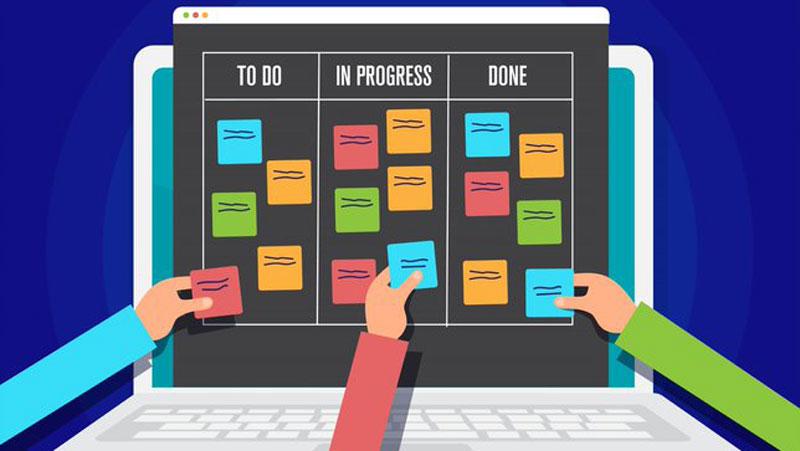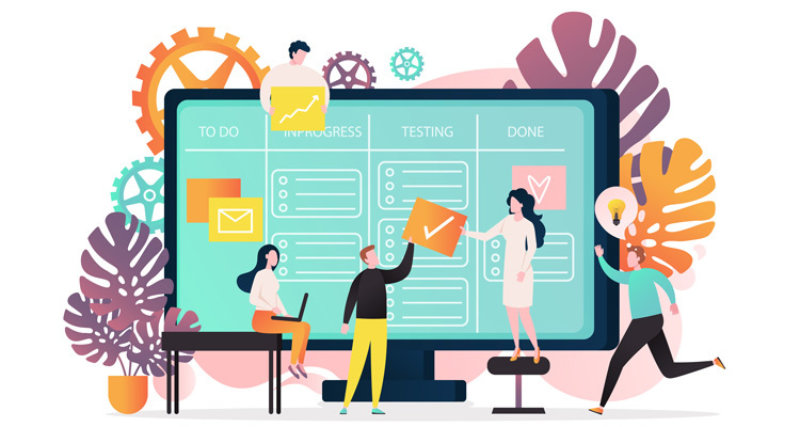
Kanban board swimlanes are horizontal lanes on your kanban board that help to separate and further define your workflow. These lanes allow teams to surface or highlight related work items or tasks that follow a similar process.
Your team might utilize swimlanes to keep track of tasks for different products or cross-team dependencies, for example. It allows you to easily spot issues or bottlenecks and identify exactly where they’re coming from so that you can keep work flowing.
There are several ways you can employ swimlanes—and most teams quickly experience the benefits of applying swimlanes to their kanban boards.
Benefits of Kanban Board Swimlanes

Utilizing swimlanes on your kanban board makes it easy for you and your team to break down your workflow to visualize related items. This ensures a clear understanding of your workload and the ability to prioritize as needed. These lanes allow you to further breakdown smaller processes that may exist within your team’s broader workflow, as well.
Kanban board swimlanes provide teams with the flexibility to manage specific product or client processes, cross-team workflows, company-level goals, and much more. With these lanes, your board maintains the full overview of your work while visually breaking down the sub-levels of your services.
How to use Kanban Board Swimlanes

Visualizing work types using horizontal lanes allows you to further separate related tasks so work continues flowing and goals are continually met. There are several different ways to use swimlanes. You and your team should base the type of kanban board swimlanes you use on your goals for workflow visualization.
There’s no right or wrong way to use horizontal swimlanes, but there are a few recommended ways that tend to work best for a majority of teams. Your team can employ swimlanes to:
- Show class of service
- Visualize cross-team dependencies
- Distinguish sub-teams, products, or clients
- Highlight recurring work
- Target company-level goals

Show Class of Service

In Kanban, “class of service” refers to the set of parameters that define how your team classifies incoming work. For example, you can utilize class of service to specify the urgency, time commitment, or other requirements that help to further visualize specific work items.
Using kanban board swimlanes to highlight class of service allows you and your team to prioritize work effectively.
Some types of class of service specifications might include tasks to expedite, items that have fixed delivery dates, or general work items. Again, there’s no specific right or wrong way to use this. Most teams identify a few class of service types that best represent their workflow and go from there.
Visualize Cross-team Dependencies

Swimlanes can also be used to visualize cross-team dependencies so that work from other teams—or work from your team that relies on other teams—can be easily surfaced and managed. Often when teams have cross-functional work items it’s easy for blocked work to get lost in the mix if it’s not visualized.
But by utilizing kanban board swimlanes to define and demonstrate cross-team dependencies on your team’s board, you’ll create further clarity and keep work moving. Plus you can have as many swimlanes as you need to clearly identify dependent work items. This way, the teams that work the most closely together within the organization can operate with cross-team clarity.
Distinguish Sub-teams, Products, Clients

Similar to visualizing cross-team dependencies, your kanban board swimlane can be used to visualize sub-teams within a team. Beyond that, you can also employ these lanes to surface clients, customers, and products. This allows you to separate processes for specific clients or varied product workflows.
For example, if you have a regularly established workflow for a specific client’s deliverables, you can easily surface this using swimlanes. You can also use it to easily visualize different product flows you and your team might use based on your organization’s offerings. Whatever the necessary workflow division, swimlanes allow you to clearly and quickly visualize it.

Highlight Repetitive Work or Recurring Work

You can also utilize kanban board swimlanes to clearly visualize consistent recurring or repeated work. Many teams have team-based, internal tasks that must be accomplished on a regular basis. It’s easy to fall into the trap of not documenting this work simply because you and your team are constantly completing it—but this allows for missed work and misrepresentation of your team’s actual workload.
Using a dedicated swimlane to track and visualize this work allows you to fully understand how often these repetitive tasks come up, distinguish how quickly your team is completing these tasks, and ensure that work is getting done. This can likewise be used for work that doesn’t follow the team’s regular process but is still worked on by the team.
Target Company-Level Goals

If your team contributes work toward company-wide goals, it can be highly beneficial to visualize larger initiatives or build a board to showcase epics or programs. If you or your organization has built a separate board for broader goals, you can link to connected boards through cards in a dedicated swimlane on your team’s board.
These board hierarchies can be incredibly helpful if your team utilizes methods like SAFe Program Increment (PI) planning. Visualizing and linking these broader goals from one larger, company-based board to individual team boards helps everyone across the organization stay on the same page and keep moving toward organization-wide initiatives.
Kanban Board Swimlanes: Customizable Clarity
Swimlanes are horizontal lanes that you can easily utilize to further clarify and define processes across your team and organization. You can employ these kanban board swimlanes to visualize the specific workflow divisions that work best for you.
Now that you’ve got an understanding of how to utilize swimlanes, take a look at these 7 Principles for Smart Kanban Board Design to help you accurately design a board that reflects your team’s process.




